Step into the smoky depths of the blues with the enigmatic legend himself, Stevie Ray Vaughan, with this guide that will unmask the secrets behind the electrifying guitar that shaped his transcendent sound. With fingers that danced across strings like a possessed maestro and a voice that echoed the heartache of a million souls, Stevie Ray Vaughan’s music not only left an indelible mark on the world of blues but also fueled the fire of countless aspiring guitarists. This article will delve deeper into the mystique surrounding this guitar virtuoso and uncover the untold story of the instrument that became an extension of his very soul.
5 Thing You Need to Know About Stevie Ray Vaughan
Stevie Raz Vaughan is a legendary blues guitarist and singer, known for his soulful playing style and captivating stage presence. He was one of the most influential musicians in the history of blues music, and his untimely death at the age of 35 left a lasting impact on the industry.
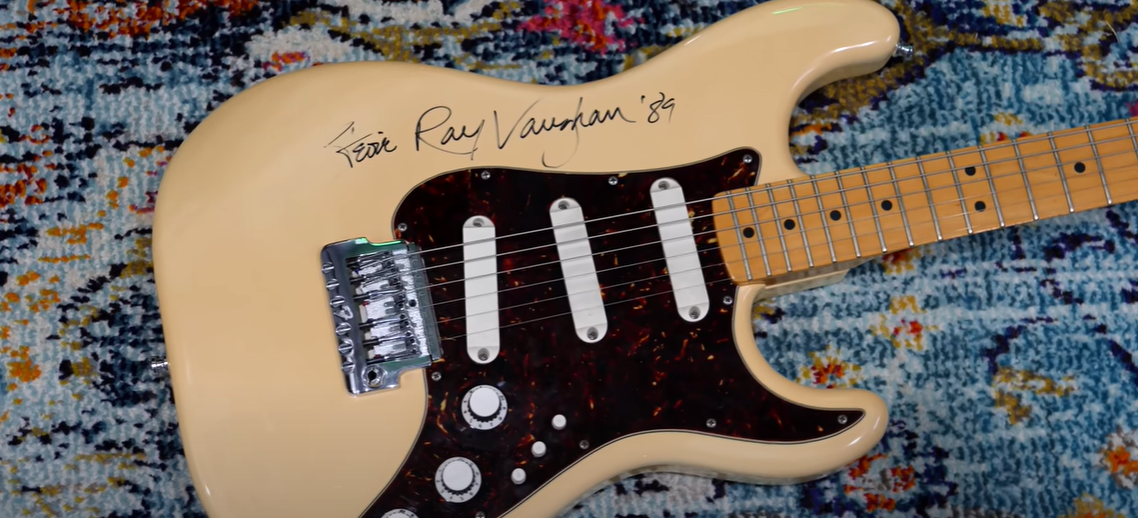
Here are 5 things you need to know about this guitar virtuoso:
- His Early Life and Musical Influences
Stevie Ray Vaughan, a legendary guitarist, was born in Dallas, Texas in 1954. Growing up in a deeply musical family, he was surrounded by the enchanting melodies of his father’s guitar and the soulful voice of his mother in the church choir. Interestingly, his older brother Jimmie Vaughan, who would later become a founding member of The Fabulous Thunderbirds, also possessed remarkable guitar skills.
Among the many musicians who left an indelible mark on Stevie’s musical journey, notable figures like Jimi Hendrix, Albert King, and Freddie King played a significant role. Their virtuosity and innovative approaches to guitar playing inspired Stevie to push the boundaries of his own artistry.
- His Rise to Fame
In the late 1970s and early 1980s, a young and talented musician named Stevie Ray Vaughan embarked on his musical journey by playing in various bands across the vibrant Texas music scene. From smoky bars to lively clubs, Stevie honed his skills, captivating audiences with his electrifying guitar solos and soulful voice.
It was during this time that Stevie’s passion for the blues blossomed, drawing inspiration from legends like Jimi Hendrix and Albert King. In pursuit of his musical dreams, Stevie eventually formed his own band, aptly named Double Trouble. With their tight rhythm section and Stevie’s mesmerizing guitar prowess, they quickly garnered attention and a dedicated fanbase.
In 1983, the stars aligned for Stevie and Double Trouble when they caught the ear of Epic Records. The record deal marked a turning point in their career, offering them the opportunity to reach a wider audience and showcase their exceptional talent on a larger scale. With the release of their debut album, “Texas Flood,” the world was introduced to Stevie’s distinctive blues sound and his unmatched guitar skills.
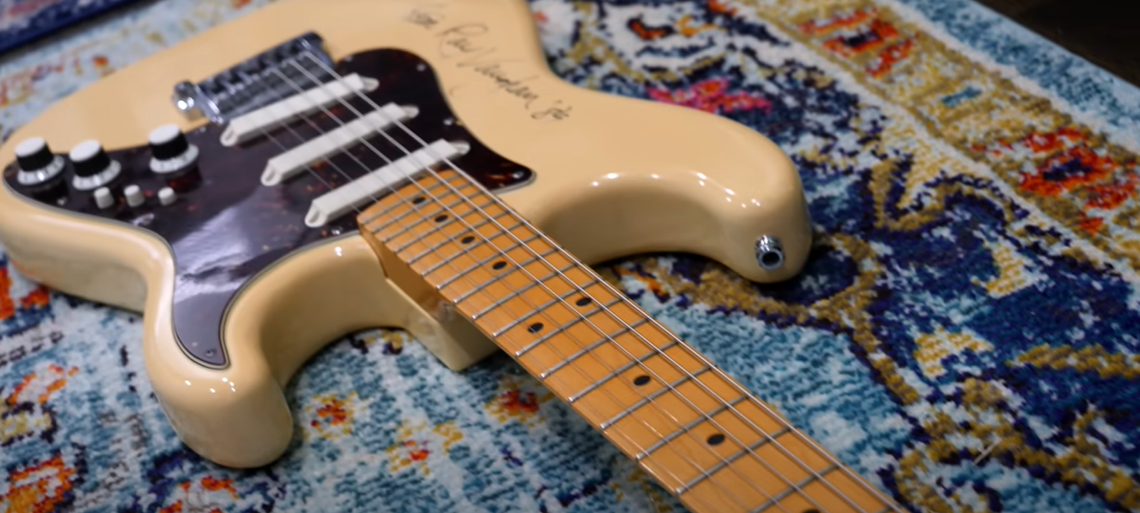
“Texas Flood” struck a chord with music lovers around the globe, propelling Stevie to new heights of fame and recognition. His incredible talent and raw emotion resonated deeply, solidifying his status as one of the greatest blues guitarists of all time.
From the smoldering guitar licks of “Pride and Joy” to the soul-stirring vocals of “Love Struck Baby,” Stevie Ray Vaughan and Double Trouble captivated audiences with their sheer musical brilliance. Their infectious energy and unwavering dedication to their craft made them a force to be reckoned with in the world of blues music.
Although tragically taken from us far too soon, Stevie Ray Vaughan’s legacy lives on. His music continues to inspire generations of musicians and his impact on the blues genre remains unmatched. Stevie’s passion, talent, and unwavering commitment to his craft serve as a testament to his enduring influence and his rightful place in music history.
- His Signature Playing Style
Stevie Ray Vaughan, the legendary guitarist, possessed a truly distinctive playing style that elevated him above other guitarists of his time. With his masterful command of the blues scale, he expertly employed techniques such as precise string bending, soulful vibrato, and lightning-fast picking to craft his unforgettable sound. His playing, characterized by its aggressive yet profoundly soul-stirring nature, captivated audiences worldwide. Every note he played carried a sense of purpose and emotion, leaving an indelible mark on the hearts of music lovers everywhere. Stevie Ray Vaughan’s extraordinary talent and dedication to his craft made him an icon of the guitar world, forever immortalized as a true maestro of his art.
- His Battle with Addiction
Despite his immense success as a guitar virtuoso, Stevie Ray Vaughan battled with the demons of drug and alcohol addiction throughout his illustrious career. Recognizing the destructive path he was on, he made the brave decision to check into rehab in the early 1980s, embarking on a journey of recovery that spanned several years. With unwavering determination, he achieved sobriety and regained control over his life.
However, the road to recovery is never without its challenges, and tragically, Stevie Ray Vaughan experienced a relapse. Undeterred by his setback, he sought help once again and entered a rehabilitation program in 1990, eager to reclaim his sobriety. Sadly, fate had a different plan in store for him. Just days after completing the program, he met with a tragic end in a helicopter crash, leaving behind an eternal legacy of musical brilliance and an indelible mark on the world of blues.
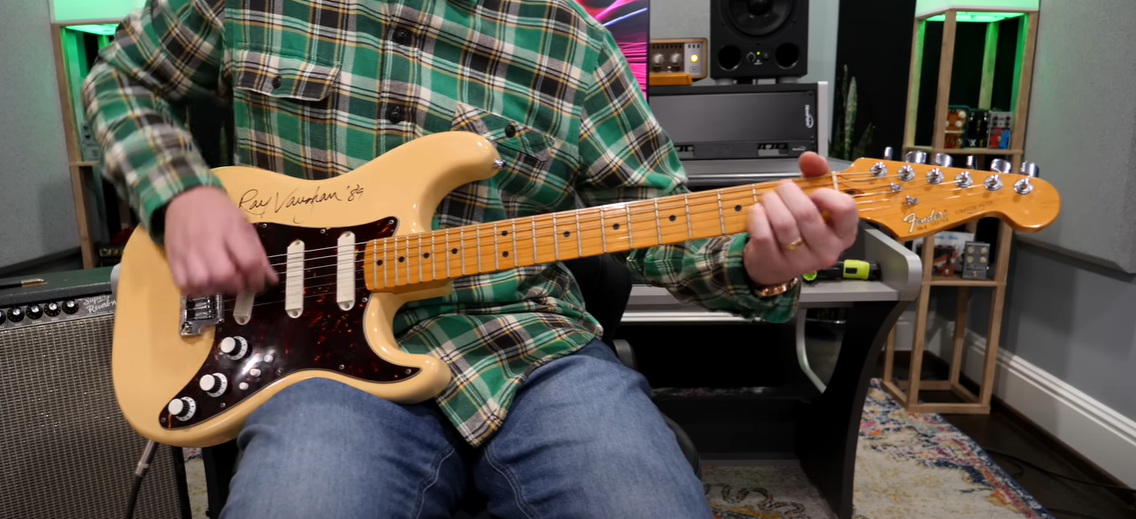
The story of Stevie Ray Vaughan serves as a reminder of the complexities of addiction, the fragility of life, and the enduring power of his music that continues to captivate generations of music lovers.
- His Legacy
Stevie Ray Vaughan, the legendary blues musician, left an indelible mark on the music world that resonates even decades after his untimely demise. His unparalleled talent and contribution to the blues genre earned him a posthumous induction into the prestigious Rock and Roll Hall of Fame in 2015, solidifying his status as one of the greatest guitarists of all time.
Vaughan’s unique playing style, characterized by his fiery guitar solos and soulful bluesy riffs, captivated audiences around the globe. His virtuosity on the guitar, combined with his emotive and raw performances, continues to inspire and influence countless musicians of all generations. Stevie Ray Vaughan’s enduring legacy not only showcases his immense talent but also serves as a testament to his pivotal role in shaping the sound and spirit of blues music [1].
Stevie Ray Vaughan’s Main Guitar: Fender Stratocaster “Number One”
Stevie Ray Vaughan’s “Number One” Fender Stratocaster is often referred to as the holy grail of electric guitars. It was his main instrument and can be heard on most of his recordings and live performances. The guitar has become synonymous with Vaughan’s signature sound and style, making it an iconic piece of music history.
However, Vaughan’s “Number One” Fender Stratocaster was not just any ordinary Strat. It was a 1963 model that he purchased from Ray Hennig’s Heart of Texas Music shop in Austin, Texas. Vaughan had noticed the guitar hanging on the wall and immediately fell in love with it, despite its hefty price tag of $350 at the time.
From there, “Number One” became an essential part of Vaughan’s career. He used it on his debut album “Texas Flood,” and it became his go-to instrument for the rest of his career. The guitar went through several modifications over the years, including a left-handed neck and a new tremolo bridge, but its iconic sound remained intact.
One of the unique features of Vaughan’s “Number One” was that he often played with the pick-up switch in the middle position, which allowed him to blend the neck and bridge pickups for a thicker sound. This became known as his signature “in-between” tone.
Sadly, “Number One” suffered several accidents throughout Vaughan’s career, including falling off stage and being run over by a tour bus. However, it was always repaired and continued to be his main guitar until his untimely death in 1990.
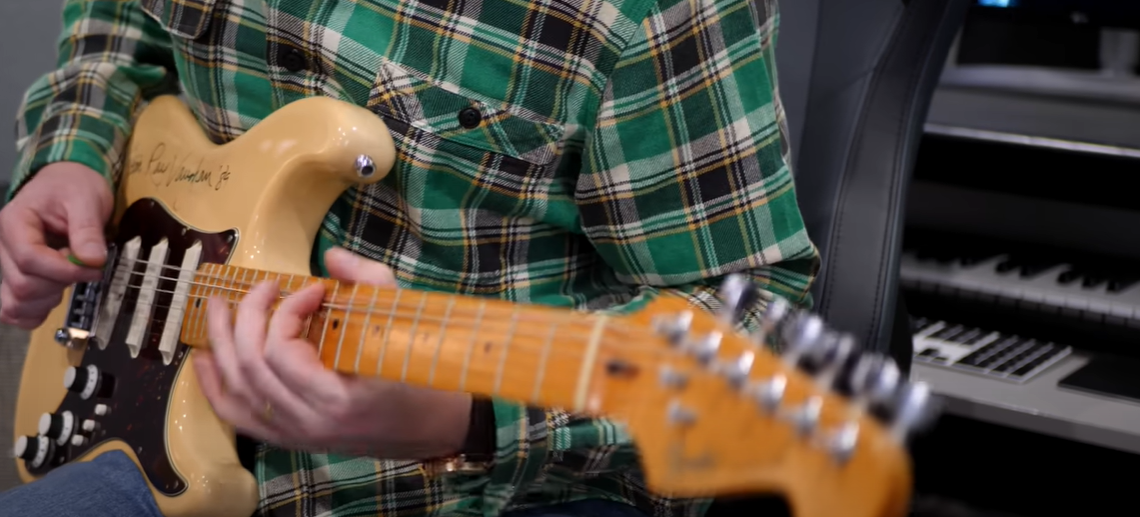
Today, “Number One” is on display at the Bullock Texas State History Museum in Austin, Texas, where it serves as a lasting tribute to Stevie Ray Vaughan’s legacy and influence on the world of music. It has also inspired countless musicians to pick up a Fender Stratocaster and try to capture that iconic sound. So, it can be said that the legacy of Stevie Ray Vaughan’s main guitar lives on through both his music and the Fender Stratocaster itself [2].
Other Important Guitars Played by Stevie Ray Vaughan
Red Special
Stevie Ray Vaughan, the legendary guitarist, was not only renowned for his mastery of the Fender Stratocaster, but he also had an unwavering admiration for various types of guitars. Among these cherished instruments was the iconic Red Special. Crafted by Brian May and his father in the early 1960s, the Red Special stands out with its visually distinctive shape and signature sound, attributed to its homemade pickups and intricate wiring. Vaughan frequently turned to this remarkable guitar for his soulful slide playing, leaving an indelible mark on tracks like “Life Without You” and “Cold Shot”. The Red Special’s unique qualities and Vaughan’s passionate connection to it make it an integral part of his musical legacy.
Gibson ES-335:
Stevie Ray Vaughan, renowned for his deep passion for the blues, demonstrated his love for this genre through his careful selection of guitars. Among his cherished collections, the Gibson ES-335 stood out prominently. This semi-hollow body guitar, distinguished for its warm and rich tonality, became an iconic instrument in both blues and jazz music. Its versatility allowed Vaughan to effortlessly navigate between various musical styles, infusing his signature blend of blues, rock, and jazz. Notably, the ES-335 played a crucial role in the creation of timeless tracks such as “Pride and Joy” and “Tightrope”. With masterful skill and precision, Vaughan’s virtuoso performance on this guitar exemplified his ability to seamlessly weave together the diverse elements of these genres into his music, leaving an enduring legacy.
Lenny Stratocaster:
Another iconic guitar in Stevie Ray Vaughan’s impressive collection was the Lenny Stratocaster, which held a significant place in his heart. This guitar had an intriguing and sentimental history, as it originally started its journey as a 1965 Fender Stratocaster, gifted to Vaughan by his beloved wife, Lenora “Lenny” Bailey.
With deep appreciation for this precious gift, Vaughan meticulously modified the guitar, adding a brass nut and gold-plated hardware. These personalized touches not only enhanced its aesthetic appeal but also contributed to its unique sound and feel, making it truly one-of-a-kind. The Lenny Stratocaster became Vaughan’s go-to instrument for soul-stirring, slow-paced ballads, allowing him to beautifully express emotions in heartfelt melodies such as “Lenny” and “Riviera Paradise”.
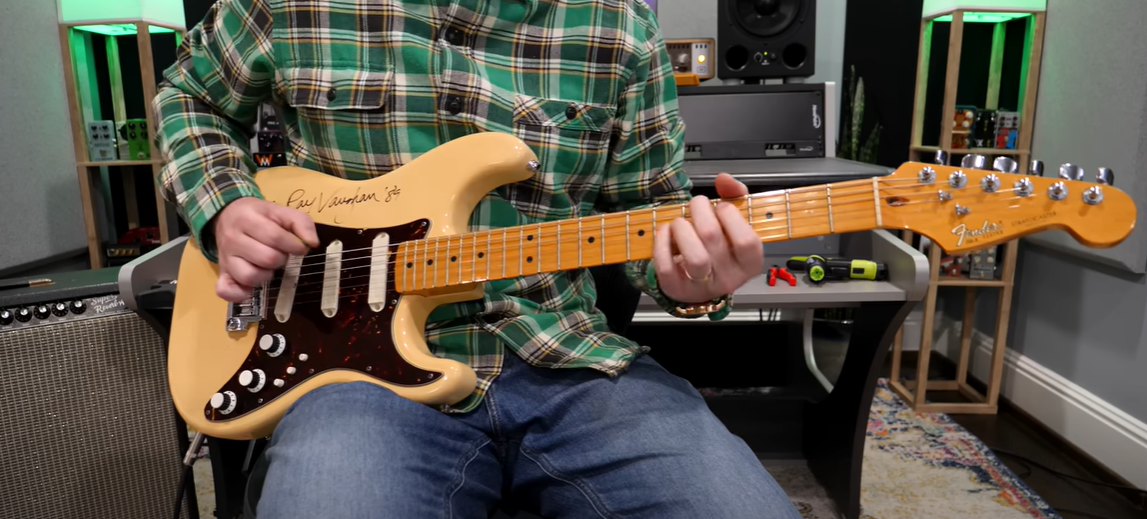
Yellow “The Wizard” Stratocaster:
One of the most iconic and instantly recognizable guitars in Stevie Ray Vaughan’s legendary collection was the Yellow “The Wizard” Stratocaster. This exceptional instrument, with a fascinating history, originally belonged to none other than the legendary Eric Clapton himself. The Yellow “The Wizard” Stratocaster was a beautifully crafted 1964 Fender Stratocaster, meticulously modified by Vaughan with a unique reverse headstock and custom pickups. These modifications not only added to its distinct appearance but also contributed to its exceptional sound quality.
Vaughan’s choice of this particular guitar was no coincidence. He was drawn to its bright and punchy tone, which perfectly complemented his unparalleled playing style. It played an instrumental role in shaping the distinctive sound that defined his music. The Yellow “The Wizard” Stratocaster can be heard prominently on beloved tracks such as “Scuttle Buttin'” and “Love Struck Baby”, where its vibrant and soulful voice truly shines.
The Yellow “The Wizard” Stratocaster remains a cherished symbol of Stevie Ray Vaughan’s unrivaled talent and musical legacy. Its captivating history, breathtaking aesthetics, and unmatched sound make it a true treasure for guitar enthusiasts and fans alike.
Charley
Charley, a 1959 Fender Stratocaster, holds a special place in the heart of blues legend Stevie Ray Vaughan. This iconic guitar was a thoughtful gift from his wife, presented to him on his birthday, and quickly became one of his cherished instruments. With its distinctive tone and smooth playability, Charley became Vaughan’s go-to guitar in the later years of his illustrious career.
Vaughan’s unmatched skill and passion brought Charley to life on numerous tracks, leaving an indelible mark on his music. From the soulful riffs of “Couldn’t Stand the Weather” to the electrifying energy of “Tightrope,” Charley’s powerful presence is felt in every note. It became an integral part of Vaughan’s signature sound, captivating audiences around the world.
Tragically, Stevie Ray Vaughan’s untimely passing in 1990 left a void in the music world, but his legacy lives on through the cherished memories and the enduring spirit of Charley. This remarkable guitar symbolizes the incredible talent and profound impact that Vaughan had on the blues genre and beyond.
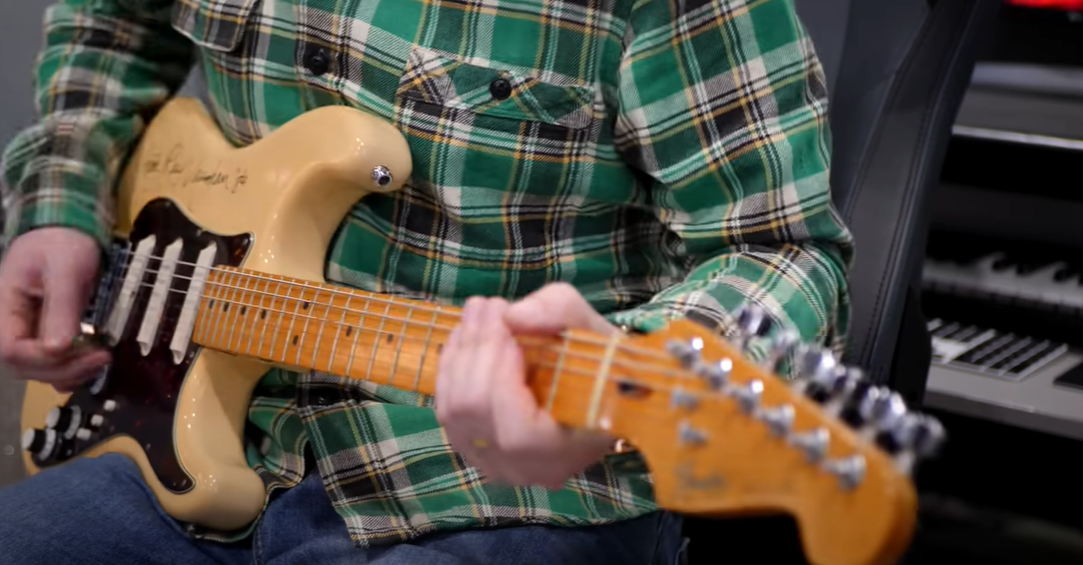
Scotch
The Scotch guitar, a rare gem in Stevie Ray Vaughan’s extensive collection, was an instrument that stood out from the rest. Acquired for a mere $50 from a humble pawn shop, this 1963 Danolectric Silvertone possessed an undeniable charm. Despite its modest price tag, the Scotch guitar quickly became an indispensable part of Vaughan’s iconic sound, owing to its distinct tone and remarkable versatility. Tracks such as “Say What” and “Lookin’ Out the Window” showcased the guitar’s unique sonic character, effortlessly bringing forth the brilliance of Vaughan’s musical prowess. It was a testament to his extraordinary ability to transform any instrument into an instrument of greatness when placed in his skillful hands. The Scotch guitar truly exemplified the artistry and magic that defined Stevie Ray Vaughan’s musical journey.
The Guitar Amplifiers that Stevie Ray Vaughan Played
Fender Super Reverb
Stevie Ray Vaughan, the legendary blues guitarist, was renowned for his early years of musical prowess where he skillfully wielded the iconic Fender Super Reverb amplifier. This amplifier, a favored choice among blues guitarists of the time, captivated audiences with its unmistakable warm and rich tone that resonated through every note played. Equipped with four 10-inch speakers, the Fender Super Reverb boasted a powerful and commanding sound that effortlessly filled up any room or stage, enveloping listeners in a sonic experience like no other.
Fender Vibroverb
Another Fender amplifier that Stevie Ray Vaughan frequently used in his performances was the Vibroverb. Renowned for its exceptional sound, this amp boasted a distinctive tone, attributed in part to its built-in tremolo effect. This effect, showcased on numerous Vaughan recordings, added a unique and captivating element to his music. Furthermore, the Vibroverb’s utilization of a tube rectifier contributed to its warm and organic sound, setting it apart from the more common solid-state amplifiers of its time. With its rich tonal capabilities and distinctive features, the Vibroverb remains a beloved choice among guitarists seeking to recreate the iconic sound of Stevie Ray Vaughan.
Marshall 1959 Super Lead
As Vaughan’s career skyrocketed and he found himself performing in increasingly larger venues, he made the switch to Marshall amplifiers, a decision that would come to define his iconic sound. Among his arsenal of amplifiers, the 1959 Super Lead stood out as one of his go-to models, renowned for its unparalleled power and ability to effortlessly cut through the mix even on the loudest of stages.
This legendary amp boasted two distinct channels – the normal channel and the high treble channel – each offering its own unique sonic qualities. On the normal channel, Vaughan could achieve a cleaner, more pristine tone, perfect for those soulful blues ballads. However, it was on the high treble channel where the amp truly came alive, delivering a searing, overdriven sound that became a signature part of his electrifying performances.
With the 1959 Super Lead by his side, Vaughan was able to command the stage with his fiery guitar solos, leaving audiences in awe of his raw talent and the unmistakable tone that only a Marshall amplifier could produce. It was an instrument that perfectly complemented his virtuosity and added an extra layer of intensity to his already electrifying performances.
Dumble Overdrive Special
One of the most legendary amplifiers that Stevie Ray Vaughan played was the Dumble Overdrive Special. Renowned for its meticulously crafted design, these amps were custom-made to cater to the unique preferences of individual players, resulting in their exceptional tonal characteristics. The Dumble Overdrive Special in particular, which Vaughan favored, boasted an exquisite combination of four 6L6 power tubes and four 12AX7 preamp tubes. This meticulous configuration delivered a rich, warm, and full-bodied tone that perfectly complemented Vaughan’s distinctive playing style, captivating audiences worldwide. Thus, the Dumble Overdrive Special stands as a testament to the artistry and innovation that defined Stevie Ray Vaughan’s musical journey.
Fender Bassman
Towards the later years of his career, Stevie Ray Vaughan began incorporating Fender Bassman amplifiers into his setup. These amps were originally designed for bass players, but many guitarists, including Vaughan, loved the warm and gritty sound they produced. Vaughan used two Bassman heads and four 10-inch speakers in his live setup to create a powerful and dynamic sound.
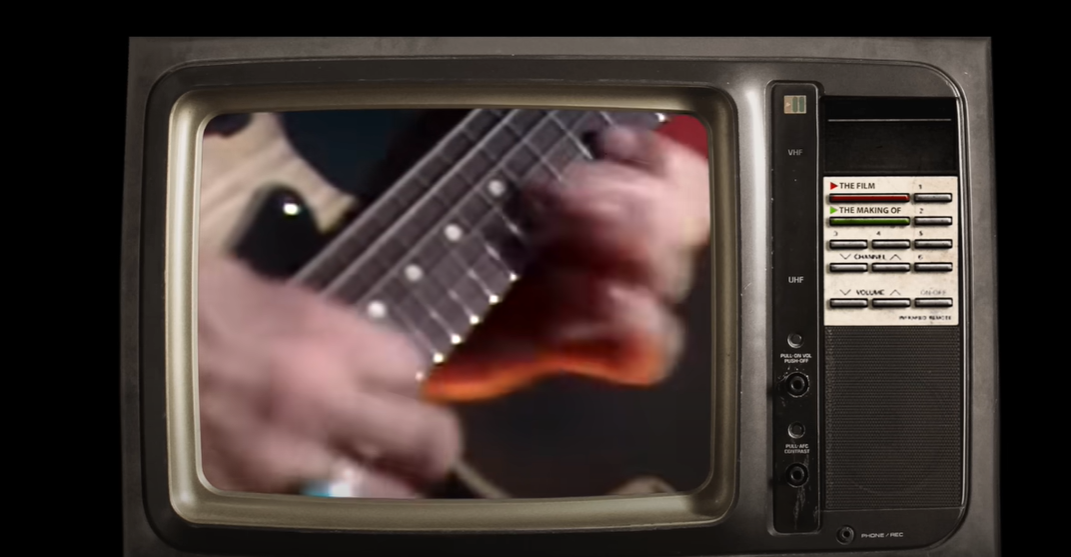
Dumble Steel String Singer
Another rare and highly sought-after amplifier that Vaughan used was the Dumble Steel String Singer. This amp is known for its incredible clean tone and ability to handle overdrive pedals with ease. Vaughan used this amp in combination with his other amplifiers to create a unique and versatile sound on stage.
The Pedals and Effects Used by Stevie Ray Vaughan
In the world of guitar playing, few names carry as much weight and respect as Stevie Ray Vaughan. Known for his fiery and soulful blues playing, Vaughan was a master at using pedals and effects to shape his iconic sound.
The Ibanez Tube Screamer – One of the most recognizable pedals in Vaughan’s arsenal was the Ibanez Tube Screamer. This overdrive pedal was a crucial part of his tone, providing the perfect amount of grit and sustain to his already powerful playing.
Fender Twin Reverb – While not technically a pedal, Vaughan’s choice of amplifier also played a huge role in shaping his sound. He often used the Fender Twin Reverb, which provided him with a clean and bright tone that allowed his playing to shine through.
Uni-Vibe – Another staple in Vaughan’s effects lineup was the Uni-Vibe. This pedal produced a swirling, chorus-like effect that added depth and warmth to his sound. It was particularly prominent on songs like “Voodoo Child (Slight Return)” and “Little Wing.”
Dallas Arbiter Fuzz Face – The iconic fuzz tone that can be heard on songs like “Pride and Joy” and “Texas Flood” was created by the Dallas Arbiter Fuzz Face. This pedal gave Vaughan’s guitar a thick, saturated tone that perfectly complemented his aggressive playing style.
Roland Space Echo – For delay effects, Vaughan often turned to the Roland Space Echo. This tape echo unit added a natural and warm delay to his sound, creating a sense of space and atmosphere in his playing.
Dunlop Cry Baby Wah – No list of Vaughan’s pedals would be complete without mentioning the Dunlop Cry Baby Wah. This pedal was a signature part of his sound, allowing him to add expressive sweeps and accents to his solos.
In conclusion, Stevie Ray Vaughan’s pedal and effects choices were crucial in creating his unique and beloved sound. Each pedal added its own distinct flavor to his playing, making him one of the most revered guitarists of all time. Even years after his passing, Vaughan’s legacy lives on through his masterful use of pedals and effects.
FAQ
What was Stevie Ray Vaughan’s main guitar?
Stevie Ray Vaughan, the legendary blues guitarist, was known for his exceptional talent and his unmistakable sound. Central to his signature style was his beloved Fender Stratocaster. Specifically, he often played a 1963 Fender Stratocaster, affectionately referred to as “Number One.” This iconic guitar became Vaughan’s faithful companion, accompanying him on stage and in the studio, and serving as the cornerstone of his musical journey. With its distinctive tone and remarkable playability, the Fender Stratocaster played a pivotal role in shaping Vaughan’s extraordinary career, leaving an indelible mark on the world of music.
Did Stevie Ray Vaughan ever play a Telecaster?
While the Fender Stratocaster was undoubtedly Stevie Ray Vaughan’s main guitar, he did occasionally play other models, including a Telecaster. In fact, before acquiring his beloved “Number One” Stratocaster, Vaughan primarily played a 1959 Fender Telecaster. He also owned and played a variety of other guitars throughout his career, such as Gibson Les Pauls and ES-335s. However, the Fender Stratocaster remained his go-to instrument and was featured prominently in most of his performances and recordings.
What made Stevie Ray Vaughan’s guitar playing unique?
Stevie Ray Vaughan’s guitar playing was truly one-of-a-kind, characterized by an unparalleled combination of technical prowess, emotional depth, and sheer passion. His playing was heavily influenced by blues legends such as Albert King, Jimi Hendrix, and B.B. King, but he managed to develop a distinctive style all his own. Vaughan’s guitar solos were known for their explosive energy and raw emotion, while his rhythm playing provided a solid foundation for his bandmates. He also had an incredible sense of tone and was a master of using effects and amplifiers to create his distinctive sound. All of these elements came together to make Vaughan’s guitar playing truly unique and unforgettable.
Useful Video: Stevie Ray Vaughan Played This Guitar…
Conclusion Paragraph
So, Stevie Ray Vaughan was undoubtedly one of the most influential and talented guitarists in history. He revolutionized blues music with his unique playing style and captivating stage presence. He inspired countless musicians, both young and old, to pick up a guitar and play. Stevie used different guitars, amps, and pedals throughout his career, but he always stayed true to his blues roots. The most popular of them all was his beloved Fender Stratocaster nicknamed “Number One.” Moreover, he worked tirelessly to overcome his struggles with addiction and mental health, ultimately leading to his untimely death. However, his legacy lives on through his music, which continues to inspire new generations of musicians.
References:
- https://guitarspace.org/players/stevie-ray-vaughan-bio-and-gear/
- https://www.thestoryoftexas.com/discover/artifacts/number1-fender-strat





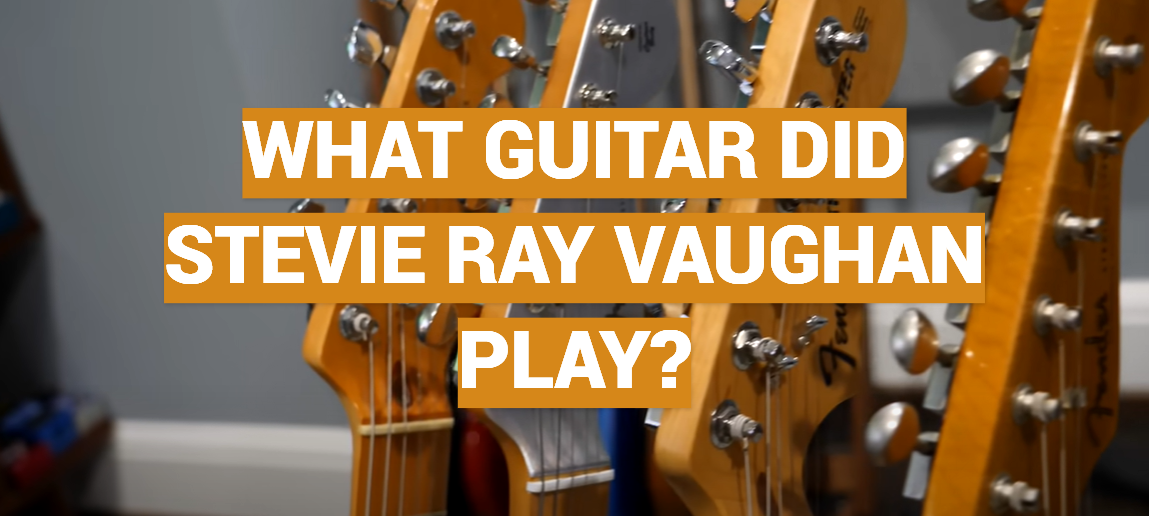




Leave a Reply